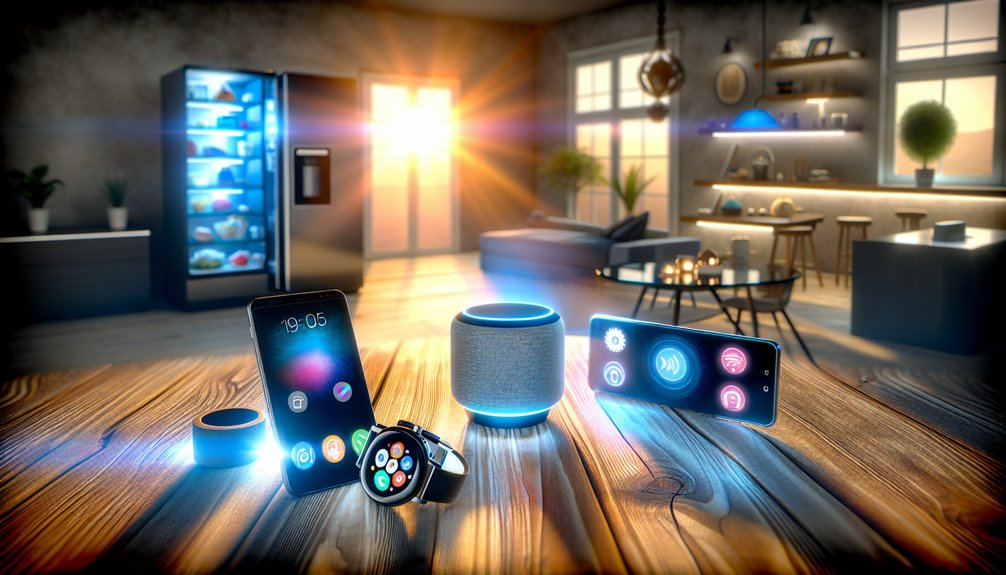The introduction of 5G technology significantly reshapes the landscape of everyday gadgets. It enhances the functionality of smart home devices, allowing for real-time communication and improved energy management. Wearable technology benefits from faster data transfer, facilitating advanced health monitoring and augmented reality experiences. Mobile phones now support seamless streaming and immersive gaming, while connected cars utilize real-time data for enhanced safety and navigation. Additionally, 5G fosters the development of smart cities, optimizing infrastructure and connectivity. As these transformations continue, a broader understanding of 5G’s impact across various aspects of daily life unfolds.
Key Takeaways
- 5G enhances smart home devices, enabling ultra-low latency for real-time communication and improved integration across various gadgets.
- Wearable technology benefits from 5G, allowing fitness trackers and smart clothing to provide real-time health monitoring and physiological tracking.
- Augmented reality applications in everyday gadgets enrich experiences, offering immersive training and rehabilitation while enhancing user engagement.
- 5G facilitates seamless streaming and gaming on mobile devices, enabling high-resolution media sharing and integration of AR and VR applications.
- Improved connectivity through 5G supports smart thermostats and voice assistants, optimizing energy consumption and allowing for multiple command processing without delays.
Understanding 5G Technology
The advent of 5G technology signifies a groundbreaking evolution in wireless communication, promising unprecedented speeds and connectivity. This next-generation network architecture is designed to support a vast array of 5G applications that extend far beyond traditional mobile internet use. With download speeds projected to reach up to 10 Gbps, 5G enables real-time data transfer, allowing for instantaneous communication between devices.
Central to 5G technology is its sophisticated network architecture, which employs a combination of low-band, mid-band, and high-band frequencies to optimize performance across diverse environments. This multi-tiered approach not only enhances capacity but also reduces latency, making it ideal for applications requiring swift responses, such as autonomous vehicles and remote surgical procedures.
Moreover, the implementation of small cell technology in urban areas enhances coverage and reliability, addressing the challenges of urban density. As industries increasingly adopt 5G, the potential for innovation expands, paving the way for smart cities, enhanced telemedicine, and immersive augmented reality experiences. In conclusion, understanding the intricacies of 5G technology is essential, as its implications will fundamentally reshape the landscape of everyday gadgets and services.
Enhanced Smart Home Devices
Leveraging the capabilities of 5G technology, smart home devices are becoming increasingly sophisticated, offering enhanced functionality and seamless integration within the modern household. The ultra-low latency and high bandwidth of 5G facilitate real-time communication between devices, which notably improves their performance and responsiveness.
One notable area of development is in smart thermostat advancements. These devices can now learn user preferences more quickly and adjust heating or cooling systems in real-time, optimizing energy consumption based on immediate weather conditions and occupancy patterns. This results in not only increased comfort but also greater energy efficiency, appealing to eco-conscious consumers.
Furthermore, voice assistant integration has reached new heights with 5G. Smart home ecosystems can now support multiple voice commands simultaneously without delays. This enhancement allows users to control various devices seamlessly—ranging from lighting to security systems—through a single voice prompt. The synergy between voice assistants and 5G empowers users with greater control over their smart environments, making daily tasks more manageable and intuitive.
Revolutionizing Wearable Technology
With the advent of 5G technology, wearable devices are experiencing a transformative evolution that enhances their functionality and user experience. The integration of high-speed connectivity allows fitness trackers to provide real-time health monitoring and data analytics, making them indispensable tools for health-conscious individuals. Enhanced accuracy from biometric sensors, coupled with rapid data transmission, enables these devices to track essential signs, physical activity, and overall wellness more effectively than ever before.
Moreover, smart clothing is at the forefront of this revolution, incorporating embedded sensors and fabrics that monitor physiological metrics seamlessly. This innovation not only promotes a more interactive fitness experience but also opens up new avenues for personal health management.
The impact of 5G extends into augmented reality (AR) applications, where wearables can overlay digital information onto the user’s environment, enriching activities such as training and rehabilitation. Virtual assistants integrated into these devices can respond to commands instantly, providing users with an intuitive interface for managing their fitness goals. As 5G continues to evolve, the potential for wearable technology to foster a connected, health-oriented lifestyle becomes increasingly profound, paving the way for a future where health management is both proactive and personalized.
Impact on Mobile Phones
5G technology is reshaping the landscape of mobile phones, propelling them into a new era of connectivity and functionality. With its blazing fast data transfer rates and reduced latency, 5G enables mobile devices to perform at unprecedented levels, allowing for seamless streaming, gaming, and communication. One of the most significant impacts of 5G on mobile phones is the enhancement of camera advancements. Users can now upload and share high-resolution images and videos in real-time, transforming the way photography and videography are experienced.
Furthermore, 5G technology facilitates the integration of augmented reality (AR) and virtual reality (VR) applications, elevating the user experience to new heights. Alongside these innovations, battery efficiency is also being optimized. Devices equipped with 5G capabilities utilize advanced power management systems, ensuring that while the phone is constantly connected, its energy consumption remains manageable. This balance between performance and battery life is essential as consumers increasingly rely on their mobile phones for more demanding tasks. Ultimately, the advent of 5G is setting new standards for mobile phones, making them more versatile, responsive, and capable of meeting the needs of a digitally connected world.
Connected Cars and 5G
The advent of 5G technology is set to revolutionize connected cars, greatly enhancing vehicle communication and operational efficiency. With ultra-fast data transfer speeds, vehicles can receive real-time navigation updates, improving safety and optimizing travel routes. This transformation not only elevates the driving experience but also paves the way for advanced features such as vehicle-to-everything (V2X) communication, essential for the future of autonomous driving.
Enhanced Vehicle Communication
In the domain of automotive technology, enhanced vehicle communication is increasingly becoming a cornerstone of modern connected cars, driven by the capabilities of 5G networks. This advancement allows vehicles to communicate not only with each other but also with infrastructure, pedestrians, and various communication networks, thereby fostering a more integrated transportation ecosystem.
The implementation of 5G enhances vehicle safety through improved data transmission speeds and reduced latency. Vehicles equipped with advanced communication systems can exchange critical information regarding road conditions, traffic patterns, and potential hazards in real-time. For instance, a connected vehicle can alert others about sudden braking or obstacles, greatly reducing the risk of accidents.
Moreover, the reliability of 5G facilitates the development of sophisticated driver assistance systems. These systems rely on continuous data streams to optimize performance and enhance situational awareness. As a consequence, the synergy between enhanced vehicle communication and 5G technology is poised to redefine road safety standards, making travel not only more efficient but also markedly safer. The evolution of connected cars is, consequently, an essential aspect of the broader movement towards smarter, safer transportation solutions in our increasingly digital world.
Real-Time Navigation Updates
Connected cars equipped with advanced navigation systems are set to revolutionize travel experiences through the integration of 5G technology. This evolution promises to enhance GPS accuracy considerably, allowing vehicles to pinpoint their locations with unprecedented precision. With 5G’s high-speed data transmission capabilities, real-time navigation updates will become a reality, providing drivers with instantaneous information about their surroundings.
Moreover, the integration of 5G will facilitate advanced traffic forecasting. Vehicles will be able to communicate with each other and with infrastructure, sharing information about road conditions, accidents, and congestion. This interconnectedness will enable predictive analytics, allowing navigation systems to suggest ideal routes, thereby minimizing travel time and improving overall efficiency.
The impact of these advancements extends beyond personal convenience; they promise to enhance road safety as well. By receiving real-time updates about potential hazards, drivers can make informed decisions, reducing the likelihood of accidents. As 5G technology continues to mature, the synergy between connected cars and navigation systems will not only transform how we travel but also reshape urban mobility and infrastructure management. The future of driving is indeed bright, driven by the convergence of technology and data.
The Future of IoT
A notable transformation is on the horizon for the Internet of Things (IoT) as 5G technology reshapes connectivity and device interaction. The integration of IoT with 5G networks will release unprecedented scalability for smart devices, facilitating seamless communication between a vast number of connected devices. This evolution is not merely an enhancement of speed; it represents a revolutionary shift in how devices operate, communicate, and respond to user needs.
With 5G’s low latency and high bandwidth capabilities, IoT systems can process and transmit data at remarkable speeds, enabling real-time responses that were previously unattainable. This advancement will considerably enhance IoT integration across various sectors, including smart homes, healthcare, and industrial applications. For instance, smart cities will leverage this technology to connect traffic systems, environmental sensors, and public services more efficiently.
Moreover, the improved smart device scalability means that more devices can be connected without compromising performance, allowing for expansive networks that foster innovation. As industries embrace 5G, the future of IoT promises smarter ecosystems, driving efficiency and elevating user experiences to unprecedented levels. This transformative potential underscores the critical role of 5G in shaping a more connected, intelligent world.
Streaming and Entertainment Services
The advent of 5G technology is set to revolutionize streaming and entertainment services, unblocking new possibilities for content delivery and user engagement. With its lightning-fast speeds and reduced latency, 5G will enhance streaming quality, allowing consumers to experience high-definition content without buffering interruptions.
- Seamless streaming of 4K and even 8K content
- Real-time interaction in live-streaming events
- Enhanced accessibility for remote users
As streaming platforms adapt to these advancements, viewers can expect an immersive experience that includes augmented reality (AR) and virtual reality (VR) integrations. The ability to stream high-quality content seamlessly will not only elevate consumer expectations but will also encourage content creators to produce more engaging and innovative offerings.
Moreover, the interactive capabilities of 5G will foster viewer engagement like never before, enabling real-time feedback and social sharing. This shift toward a more connected and interactive entertainment landscape indicates a significant transformation in how audiences consume content. Ultimately, 5G will redefine the streaming experience, making it more dynamic, collaborative, and tailored to individual preferences.
Health Tech Innovations
Advancements in health technology are poised to undergo a transformative shift with the rollout of 5G, heralding a new era of innovation in patient care and medical practices. The enhanced speed and connectivity of 5G networks will markedly improve remote patient monitoring systems. These systems allow healthcare providers to track essential signs and health metrics in real-time, leading to timely interventions and improved patient outcomes.
Moreover, telehealth advancements will be accelerated by 5G’s capabilities. High-definition video consultations will become seamless, enabling physicians to conduct thorough examinations remotely. Patients will benefit from reduced wait times and increased access to specialists, especially in rural or underserved areas. This technology will also facilitate the integration of wearable devices that continuously collect health data, feeding into a centralized system for extensive analysis.
Furthermore, 5G can enhance data security and privacy, addressing one of the major concerns in digital health. As healthcare systems become increasingly interconnected, the potential for innovative applications, such as AI-driven diagnostics and personalized treatment plans, will burgeon. The convergence of 5G and health technology promises not only to enhance operational efficiency but also to redefine the patient experience fundamentally.
Smart Cities and Infrastructure
The advent of 5G technology promises to revolutionize smart cities and infrastructure by enhancing connectivity across various devices and systems. This increased bandwidth facilitates real-time data processing, enabling cities to respond dynamically to changing conditions, such as traffic patterns and energy consumption. Consequently, smart traffic management solutions can optimize flow and reduce congestion, ultimately leading to more efficient urban environments.
Enhanced Connectivity Benefits
One of the most significant advantages of 5G technology is its potential to revolutionize smart cities and infrastructure, enhancing connectivity in ways previously deemed impossible. As urban areas continue to grow, the need for efficient, interconnected systems becomes paramount. 5G facilitates seamless communication between smart devices, paving the way for improved urban management.
- Enhanced traffic management through real-time data sharing
- Increased energy efficiency via smart grid technologies
- Improved public safety with connected surveillance systems
The integration of smart devices within urban environments allows for greater responsiveness to changing conditions, enabling cities to adapt dynamically to various challenges. For instance, real-time communication between vehicles and traffic lights can reduce congestion and lower emissions, while smart waste management systems can guarantee optimal resource allocation.
Furthermore, 5G’s high bandwidth guarantees that numerous devices can operate simultaneously without latency issues. This not only enhances the operational capabilities of smart devices but also enriches the user experience. By fostering greater smart device integration, 5G stands to redefine how cities function, ultimately leading to more sustainable and livable environments.
Real-Time Data Processing
Real-time data processing emerges as a cornerstone of smart city infrastructure, fundamentally transforming how urban environments operate. With the advent of 5G technology, the capabilities of edge computing are markedly enhanced, allowing data to be processed closer to its source. This minimizes latency and enables immediate responses to changing conditions, a vital aspect for managing urban systems effectively.
In smart cities, vast amounts of data generated by connected devices—ranging from environmental sensors to public safety cameras—are analyzed in real-time. Advanced data analytics techniques sift through this data to provide actionable insights, helping city planners and administrators make informed decisions swiftly. For instance, real-time monitoring of air quality can trigger immediate actions, such as deploying resources to combat pollution.
Moreover, the integration of edge computing with real-time data processing allows for localized decision-making, reducing the burden on centralized data centers. This decentralized approach not only enhances efficiency but also bolsters resilience against potential system failures. As cities continue to evolve into smart ecosystems, the role of real-time data processing, powered by 5G, will be essential in fostering sustainable, responsive urban environments.
Smart Traffic Management
As urban populations continue to swell, the need for efficient traffic management systems becomes increasingly critical. The integration of 5G technology is poised to revolutionize how cities handle mobility, enhancing overall traffic flow and facilitating congestion reduction. Smart traffic management systems leverage real-time data to optimize traffic patterns and improve urban planning.
- Enhanced communication between vehicles and infrastructure
- Real-time monitoring of traffic patterns and incidents
- Adaptive traffic signal control based on live data
By enabling vehicles to communicate seamlessly with traffic signals, road sensors, and other vehicles, 5G creates an interconnected ecosystem that can dynamically adjust to changing conditions. This immediate data exchange allows for responsive traffic signal adjustments, leading to smoother traffic flow and minimization of delays.
Moreover, the ability to analyze vast amounts of data provides city planners with insights into traffic behavior, allowing for proactive measures to alleviate congestion. With the implementation of smart traffic management systems powered by 5G, cities can not only enhance the commuter experience but also greatly reduce their environmental footprint, creating a more sustainable urban future. The potential for innovation in this sector is immense, marking a pivotal step towards smarter cities.
Gaming in a 5G World
The advent of 5G technology is poised to revolutionize gaming by markedly enhancing connectivity, speed, and overall user experience. With its significant latency reduction, 5G enables seamless cloud gaming, allowing players to access high-quality games without the need for extensive hardware. This shift not only democratizes gaming but also fosters expansive gaming ecosystems where players can engage in rich, immersive experiences.
Moreover, 5G’s capabilities enhance augmented reality (AR) and virtual reality (VR) gaming, creating more dynamic interactions. Gamers can enjoy multiplayer experiences that are more fluid and responsive, vital for competitive environments such as mobile esports. The reduced latency guarantees that actions are executed in real-time, giving players essential competitive advantages.
As 5G networks proliferate, the potential for innovative game design expands, allowing developers to integrate complex mechanics and rich graphics without compromising performance. This evolution will likely encourage a surge in collaborative and competitive gameplay, redefining social interactions within the gaming community. Ultimately, the shift to a 5G-enabled gaming world promises not only to elevate individual experiences but also to reshape the landscape of the gaming industry as a whole.
Security Improvements With 5G
The advent of 5G technology brings significant enhancements in security protocols for connected gadgets. With improved data encryption methods, users can expect a higher level of protection against unauthorized access and data breaches. Additionally, the capability for real-time threat detection allows for immediate responses to potential vulnerabilities, ensuring a safer digital environment.
Enhanced Data Encryption
Revolutionizing the landscape of digital security, 5G technology introduces enhanced data encryption protocols that greatly strengthen the protection of sensitive information. As the digital world becomes increasingly interconnected, the need for robust security measures has never been more essential. The adoption of 5G paves the way for advanced encryption methods, including quantum encryption, which offers a considerable leap in safeguarding data against potential breaches.
- Improved privacy protocols: 5G’s architecture facilitates stronger encryption techniques, guaranteeing that user data remains confidential.
- Resistance to cyber threats: Enhanced encryption creates formidable barriers against unauthorized access, markedly reducing vulnerabilities.
- Support for IoT devices: With the proliferation of Internet of Things (IoT) gadgets, 5G guarantees that these devices can communicate securely with robust encryption mechanisms.
These innovations not only protect individual and organizational data but also foster trust in digital ecosystems. As we navigate an era where data breaches are rampant, the enhanced encryption capabilities provided by 5G represent a crucial advancement in securing our digital lives and guaranteeing a more resilient technological infrastructure.
Real-Time Threat Detection
Leveraging the ultra-fast connectivity and low latency inherent in 5G networks, real-time threat detection becomes a crucial component in enhancing cybersecurity measures. This advancement allows organizations to monitor network activities continuously, swiftly identifying and responding to potential threats. The integration of advanced threat intelligence systems with 5G capabilities enables devices to communicate more effectively, sharing essential information about emerging threats across vast networks.
In this landscape, proactive measures are not just beneficial; they are indispensable. 5G facilitates the aggregation of data from various endpoints, creating a thorough view of security postures. By employing machine learning algorithms, systems can analyze patterns and anomalies in real time, leading to quicker identification of suspicious activities. This immediate response capability considerably reduces the risk of data breaches and cyberattacks.
Moreover, the enhanced bandwidth of 5G networks supports the deployment of more sophisticated security protocols, ensuring that even the most complex threats are managed efficiently. As organizations embrace 5G technologies, the potential for real-time threat detection serves as a cornerstone for building robust cybersecurity frameworks, fostering a safer digital environment for users and devices alike.
Environmental Considerations of 5G
As cities increasingly embrace the rollout of 5G technology, a range of environmental considerations emerges that merit careful examination. While 5G promises enhanced connectivity and innovation, it also raises concerns about its impact on the environment.
- 5G emissions: The energy consumption associated with the deployment and operation of 5G networks can lead to increased greenhouse gas emissions.
- Sustainable infrastructure: Developing energy-efficient solutions and integrating renewable energy sources into 5G infrastructure is essential for minimizing ecological footprints.
- E-waste management: The rapid evolution of technology may result in a surge of electronic waste as outdated devices are replaced, posing disposal and recycling challenges.
As we navigate the shift to 5G, it is imperative to prioritize sustainable practices in infrastructure development. The increased density of antennas and base stations required for peak 5G performance necessitates careful planning to mitigate the resulting emissions. By emphasizing sustainability, stakeholders can leverage the benefits of 5G while addressing its environmental implications. Ultimately, the challenge lies in balancing technological advancement with ecological responsibility, ensuring that the future of connectivity aligns with our commitment to the planet.
Frequently Asked Questions
How Will 5G Affect Battery Life in Devices?
5G technology may initially increase energy consumption due to higher data transmission rates. However, advancements in battery efficiency could mitigate this effect, leading to improved overall battery performance in devices as they adapt to the new standards.
What Are the Costs Associated With Upgrading to 5G?
The global investment in 5G infrastructure is projected to reach $1 trillion by 2025. Consequently, upgrade expenses for consumers will vary, influenced by device compatibility, network rollout pace, and potential subscription fee adjustments.
Will Older Devices Benefit From 5G Technology?
Older devices may experience limited benefits from 5G technology due to legacy compatibility issues, which can hinder ideal device performance. However, certain enhancements in connectivity may still improve functionality for some legacy gadgets under specific conditions.
How Does 5G Impact Internet Service Providers?
In an era reminiscent of the Gold Rush, 5G elevates network competition among internet service providers, compelling them to enhance service reliability. This technological advancement necessitates significant infrastructure investments, reshaping market dynamics and consumer expectations.
What Regulations Govern the Deployment of 5G Technology?
The deployment of 5G technology is governed by regulations concerning spectrum allocation and safety standards, ensuring efficient use of electromagnetic spectrum resources while maintaining public health and environmental safety through established guidelines and compliance requirements.
Conclusion
To summarize, the advent of 5G technology heralds a transformative era for everyday gadgets, enhancing connectivity and functionality across various domains. As smart home devices, wearables, and mobile phones evolve, they weave a tapestry of innovation that enriches daily life. The potential for connected cars and smart cities paints an exhilarating picture of future infrastructure. Ultimately, the implications of 5G extend beyond mere speed, promising a seamless integration of technology that could redefine human experience in profound ways.







